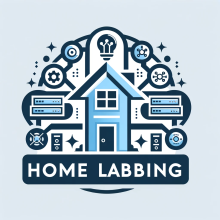Welcome to my home lab, a space dedicated to learning, experimentation, and a bit of fun. What started as a curiosity has grown into a robust environment where I run various services to support my consulting business and enjoy some entertainment on the side.
In this blog post, I'll take you through the ins and outs of my home lab setup. From the hardware I use to the network configuration, virtualization, and containerization strategies, you'll get an inside look at how everything fits together. Whether you're interested in setting up your own home lab or just curious about mine, I hope you'll find some valuable insights and maybe even some inspiration.
Let's dive in and explore the systems and services that keep my home lab running smoothly.
1. Hardware and Network Infrastructure
Hardware Details
My home lab is powered by five older Dell and HP desktop PCs, each equipped with Intel i5 processors and 12-16 GB of memory. These machines might not be the latest and greatest, but they serve the purpose well. Each node in the setup has two 1 TB hard drives, providing ample storage for the various VMs and containers…
Birdwatching has been a long-time hobby of mine, but I've found that modern life often makes it difficult to find the time to watch, identify, and catalog the birds that visit my yard. The patience—and presence—required to spot new and rare species often conflicts with not only my busy work schedule but also my ADHD. However, thanks to advances in technology, I've found a way to enjoy this activity more easily. I've embarked on a project that combines my passion for birdwatching with my skills in technology, resulting in a live-streamed bird camera that anyone can access online. Here’s how I did it.
Camera Setup
At the heart of my setup is the Reolink RLC-822A, a 4K dome camera that boasts impressive features suitable for capturing the finest details of my…
The healthcare sector is witnessing a paradigm shift with the adoption of cloud-based applications, offering a myriad of benefits such as enhanced collaboration, security, and scalability. Organizations are leveraging platforms like Office 365, cloud-based finance, medical billing tools, and Electronic Health Record (EHR) systems to streamline operations. However, the transition to the cloud raises a pivotal question: Is there still a need for a data warehouse, investment in analytics tools, and dedicated staffing in this domain?
The Essence of Data Warehousing:
Healthcare organizations emphasize the importance of retaining control, visibility, and ownership of patient and organizational data, even in a cloud-centric environment. A separate data warehouse facilitates the integration of data from diverse systems, enabling a holistic view of financial performance, patient care, scheduling, and payroll data. This independence from vendor-specific reporting tools ensures adaptability to changing reporting needs and compliance requirements.
Leveraging Analytics Tools:
The utilization of analytics tools like Power BI is not about investing in new…
In the dynamic landscape of healthcare, where cloud-based solutions are becoming ubiquitous, organizations are strategically aligning data warehousing and analytics to drive success. This strategic approach is not just about managing vast volumes of data, but about empowering organizations to make informed decisions, comply with regulations, and secure data effectively.
Securing Data and Compliance
One of the paramount concerns in healthcare is securing data and ensuring compliance. The risks associated with misuse and misconfiguration by internal actors are significant in cloud-based environments. A data warehouse addresses these concerns by providing a secure, disconnected copy of the data, enabling organizations to view data as a point in time and comply with retention requirements.
This approach is invaluable in ensuring data security irrespective of changes in vendors or cloud system issues. It allows healthcare organizations to meet the stringent requirements of funders and regulators, safeguarding the integrity of patient and organizational data.
Scalability and Complexity
The healthcare sector is witnessing a surge in data volumes,…
The healthcare sector is embracing a plethora of cloud-based tools, ranging from communication platforms like Office 365 to specialized applications for finance, medical billing, and Electronic Health Record (EHR) systems. These tools are instrumental in enhancing operational efficiency and collaboration. However, alongside the advantages, they bring forth unique challenges, particularly in data management and analytics.
Leveraging Analytics Tools
The focus in healthcare is not merely on adopting new technologies but on maximizing the potential of existing analytics tools such as Power BI. These tools are pivotal in creating interactive dashboards that offer valuable insights to stakeholders across various departments. The ability to visualize and interpret data effectively is crucial for informed decision-making in healthcare.
The indispensable role of expertise in analytics tools cannot be overstated. The organization’s ability to meet diverse reporting requirements hinges on the knowledge and skills of its staff and consultants. Ensuring that the workforce is adept in utilizing these tools is essential for harnessing the full spectrum of benefits they…
In an era where healthcare organizations are rapidly adopting cloud-based applications, the industry is experiencing a transformative shift. From communication and collaboration tools like Office 365 to Electronic Health Record (EHR) systems, the cloud is reshaping healthcare operations. However, this transition prompts a pivotal inquiry: Why is there still an imperative need for data warehousing and analytics in healthcare?
The Essence of Data Warehousing
Healthcare organizations are increasingly recognizing the importance of maintaining control, visibility, and ownership of their patient and organizational data. This need stems from a desire to avoid vendor lock-in and ensure adaptability to ever-changing reporting needs and compliance requirements.
A separate data warehouse serves as a cornerstone in achieving this goal. It facilitates the integration of data from a myriad of systems, providing a holistic view of various aspects such as financial performance, patient care, scheduling, and payroll data. This independence from vendor-specific reporting tools is crucial, allowing organizations to remain agile and responsive to the evolving healthcare…
Data warehousing project:
Over the last several years I have been engaging in a project of creating and maintaining a data warehouse for a non-profit healthcare organization. This has been a challenging but rewarding project that I was fortunate to be a part of. During this project I have served in multiple roles, acting as a project manager, software engineer writing integrations and transformations in multiple language, performing data analysis, defining processes for non-technical staff to create, update and transform data to be compatible with the needs to the data warehousing project, as well as supervising technical and non-technical staff engaged in completing this project.
I am a firm believer that no project like this will ever be “done”, however as this project has moved forward we have made some decisions and performed research that I feel is worth sharing that may help others who are engaging in similar projects. This post briefly touches on the process we engaged in and our motivation behind selecting the methods and technologies along the way, this is in no way enough information to complete a project of this size on it’s own.
…




